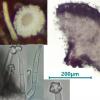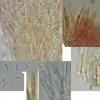
03-09-2025 21:59
Philippe PELLICIERLa Léchère, Col de la Madeleine, alt 1970m, au s

04-09-2025 20:11
Åge OterhalsSaccobolus on dear droppings. Can any of you confi

03-09-2025 12:44
Hi to somebody.I would like to know your opinion o

31-08-2025 19:41
Hi to someone.I need to download this issue of Sve

02-09-2025 11:34
Thomas Læssøehttps://svampe.databasen.org/observations/10527903

31-08-2025 17:32
 Michel Hairaud
Michel Hairaud
Bonjour, Pas d'identité trouvée pour cette réc

01-09-2025 08:42
François CorhayUn ami, conservateur d'une RN en Belgique, m'a adr

31-08-2025 14:34
Thomas FlammerI have found a Rutstroemia on abt. 2000 m on Alnus

29-08-2025 19:04
Thomas FlammerSpores 21.2 - 26.2 x 8.3 - 11.3 µm - Q: 2.20 - 2.
For once the path through the main key of Raitviir (2004) was short: two steps to Graddonidiscus and in the genus key one step to G. vandae. Then the problems start.
This fungus was growing on an old leaf of Vaccinium myrtillus(?) attached to a dropping of elk (Alces alces) in a boggy habitat, just a few minute scattered apos. Finland. Spores 4.7 - 5.6 × 1.4 - 1.9 µm; asci approx. 25 x 3-4; paraphyses lanceolate, about 45 x 5; ectal excipulum textura prismatica.
I would appreciate any help with this.
Stefan

Hi Stefan,
To me this looks like Lachnum rhytismatis with its crystal-capped hairs combined with the substrate. I remember finding quite frquent ascomata on fallen leaves of Vaccinium myrtillus.
Best wishes,
Charles.


